The Indian shield consists of five major Archean Cratons: Dharwar, Bastar, Singhbhum, Bundelkhand, and Aravalli. The Indian shield, comprising the Precambrian basement, is primarily made up of granitic gneisses and migmatites, known as the Peninsular Gneiss or Fundamental Gneiss. The Peninsular Gneiss was emplaced on an older Greenstone belt, a relic of the Primordial Crust, specifically within the Dharwar craton.
The Dharwar Craton
The Dharwar craton is a classical greenstone-granite terrain, divided into the Western and Eastern Dharwar cratons (WDC and EDC), separated by the Chitradurga Shear Zone near the linear Closepet Granite. The boundary between the two is not sharp, with the Chitradurga Shear Zone being a narrow geosynclinal belt, or Schist belt.
- Western Dharwar Craton (WDC): This region primarily consists of Tonalite-Trondhjemite-Granodioritic (TTG) gneiss, known as Peninsular Gneiss, which dates back to over 3000 million years (My).
- Eastern Dharwar Craton (EDC): This region features a granitic terrain called the Dharwar Batholith, which dates back to over 2500 My.
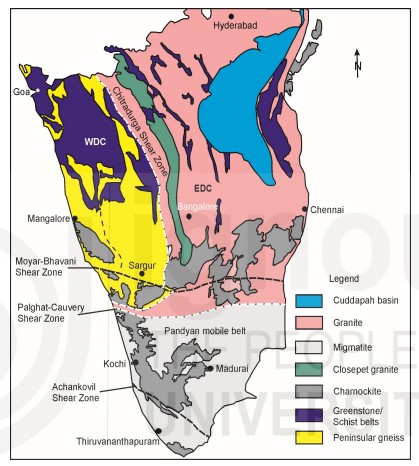
Geological Boundaries
The Dharwar craton is bounded in the south by the Pan-African Pandyan Mobile Belt, also known as the Southern Granulite. In the north, it is bounded by the End Cretaceous Deccan Traps, in the northeast by the Godavari Graben, and to the east by the Neo-Proterozoic Eastern Ghat Mobile Belt. This extensive region spans from coast to coast, covering vast geographic expanses including Goa, Karnataka, northwestern Tamil Nadu, and Andhra Pradesh.
Historical Context
The cratonic terrain derives its name from the township of Dharwar in northwestern Karnataka, where it was first studied in detail by R.B. Foote in 1882. The overall structure of the Dharwar craton is characterized by extensive folding, tight synclines and anticlines, faulting, and intense metamorphism.
Difference between WDC and EDC
| Western Dharwar Craton (WDC) | Eastern Dharwar Craton (EDC) |
| 1. Dharwar schist belts – large, with volcanic, subordinate sediments | 1. Dharwar greenstone belts – narrow, with dominant pillowed basalts |
| 2. Peninsular Gneiss (>3000 Ma) basement having angular unconformity with the Dharwar marked by QPC. Basement gneiss inliers within schist belts | 2. Dharwar Batholith (2500-2700 Ma) intrusive on all sides. Diapiric gneiss domes common |
| 3. Threefold succession of: | 3. Threefold succession of: |
| (i) basalt-arenite-BIF | (i) Shelf sediments disrupted into screens at the belt margins |
| (ii) Shelf facies at the margin and homotaxial pillowed basalt-BIF in deeper waters | (ii) Pillowed volcanic, greywackes, BIF |
| (iii) Greywackes-BIF-volcanic | (iii) Felsic volcanic, volcanogenic conglomerate (‘Champion Gneiss’) |
| 4. Older sequence (Sargur Group) as narrow belts and enclaves, abundant in the south | 4. Older sequence (Warangal Group) – mostly as enclaves in the northeast, and (Salem Group?) in the south |
| 5. Intermediate pressure (kyanite-sillimanite type) metamorphism | 5. Low-pressure (andalusite-sillimanite type) metamorphism |
Classification of Dharwar
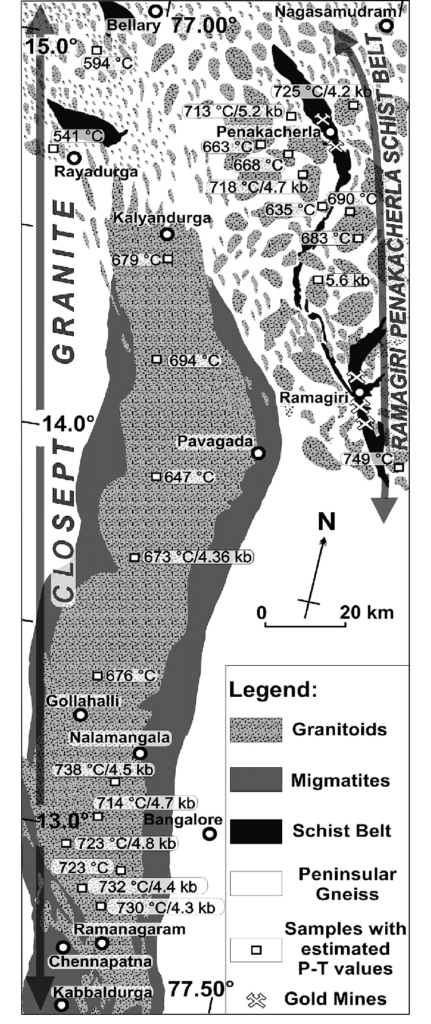
Western Dharwar Craton (WDC)
The Western Dharwar Craton (WDC) is predominantly occupied by vast areas of Peninsular Gneiss, along with two prominent super belts: Bababudan-Western Ghats-Shimoga and Chitradurga-Gadag, which belong to the Dharwar Super Group. The Gorur Gneiss is the oldest gneiss in WDC, consisting of a suite of trondhjemitic gneisses with associated tonalites and granodiorites (TTG). The Sargur Group of rocks were deposited during 3130-2960 million years ago.
Chitradurga-Gadag Super Belt
Commonly known as the Chitradurga Schist Belt, this belt is about 400 kilometers long and contains gold and K-rich granitoids. It consists of phyllite, limestone, manganese formations, and Banded Iron Formation (BIF).
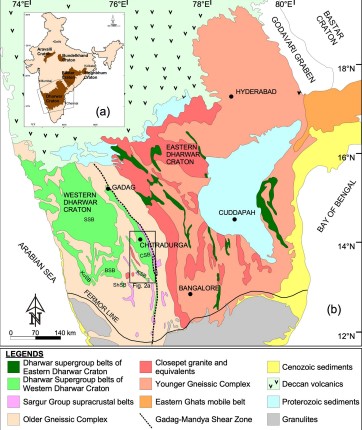
Younger Granites in WDC
- Late to post-tectonic Dharwar granites (~2600 Ma): These granites indicate crustal reworking in WDC and occur as isolated intrusions cutting across Peninsular Gneiss (3000 Ma).
- Important Granites:
- Chamundi Granite (800 Ma)
- Chitradurga Granite
- Jampalnaikankote (J.N. Kote) Granite
- Arsikere and Banavara Granites
- Hosadurga Granite
- Alkali Granites and Syenite
These granites occur as isolated plutons in the gneissic country rock.
WDC Classification
The Dharwar Craton is classified into the older Sargur Group and the younger Dharwar Super Group.
- Sargur Group: Age is tentatively considered to be 3.4-3.0 billion years. Found as belts, enclaves, narrow bands, and stringers near Sargur town, 40 km southwest of Mysore city. Lithology includes quartzite, quartz fuchsite-muscovite schists, bedded barites, sillimanite-garnet-staurolite-kyanite-graphite-corundum-quartz-biotite schists, crystalline limestone, dolomites, calc-silicate rocks, amphibolite (metabolite), iron stones (oxide and silicate facies BIF), meta ultramafic and anorthosites. The Sargur enclaves represent elongated and locally faulted syn-formal keels and antiformal hinges.
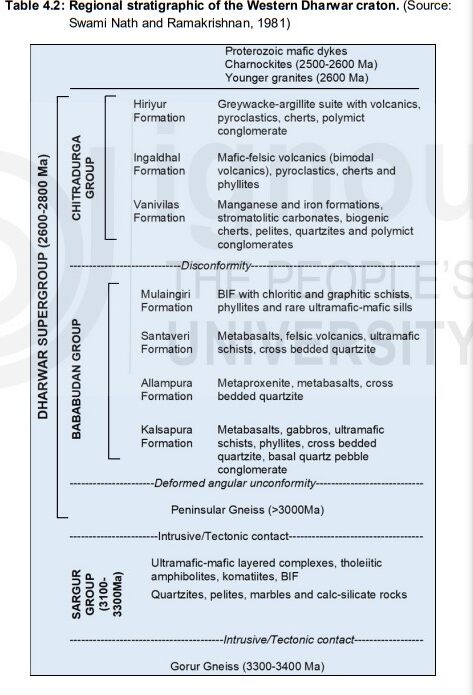
Eastern Dharwar Craton (EDC)
The EDC is bounded to the north by the Deccan Traps and the Bastar Craton, to the east by the Eastern Ghats Mobile Belt, and to the south by the Southern Granulite Terrain. The craton is composed of the Dharwar Batholith (dominantly granitic), greenstone belts, intrusive volcanic, and middle Proterozoic to more recent sedimentary basins. The supra crustal belts of the EDC are smaller in size than those of the western blocks and are surrounded by gneisses and granites.
Characteristics of EDC
- Greenstone Belts: These are zones of metamorphosed mafic/ultramafic sequences associated with Archean cratons, known as Eastern greenstone belts due to their geographic position.
- Superbelts in EDC:
- Ramagiri-(Penakacherla-Sirigeri)-Hungund superbelt
- Lolar-Kadiri-Jonnagiri-Hutti Superbelt
- Veligallu-Raichur-Gadwal superbelt
- Sandur Superbelt
Younger Intrusions
- Joga Granite: Occurring within the Sandur belt contains fluorite and carbonate yields SHRIMP U-Pb age of 2570 Ma.
- Koppel Syenite: An elongate, wedge-shaped intrusion trending NE-SW, with steep bending in contact with host granite to the NW of Sandur belt.
Closepet Granite
- The Closepet Granite is a unique linear arcuate body, nearly 500 km in length and 20-25 km in width, consisting of diverse granitic types. It is a composite body of predominant potash-rich adamellite, quartz-monzonite, and granite, believed to have been emplaced along a crustal-scale shear zone during the Late Archaean (~2600 Ma). It shows no substantial effects of deformation or metamorphism.
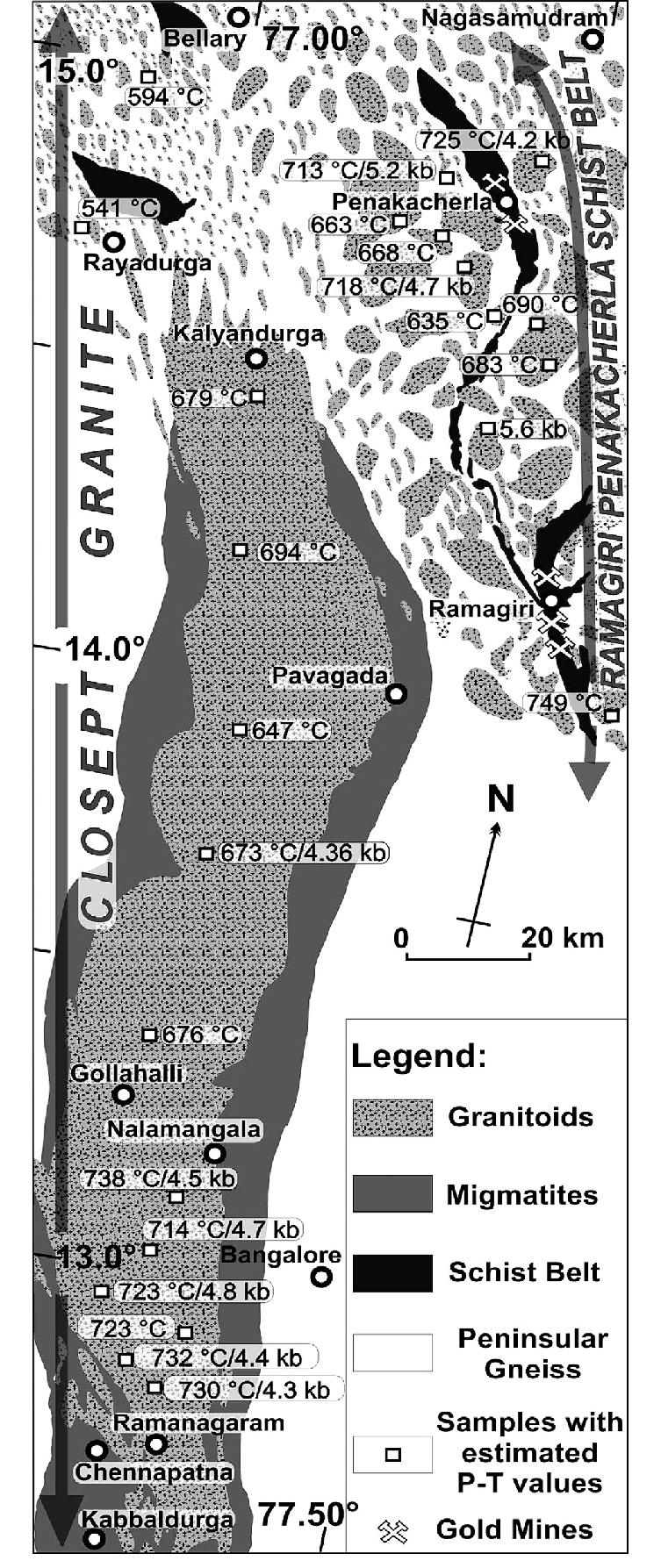
Metamorphism of Dharwar
- Western Dharwar: The regional metamorphism is of the classical Barrovian type (Kyanite-Sillimanite).
- Eastern Dharwar: The regional metamorphism is of Buchan type (Andalusite-Sillimanite).
- The Sargur Group of rocks is metamorphosed from middle amphibolite facies in central Karnataka to upper amphibolite and granulite facies in southern Karnataka. There is a progressive change in regional metamorphism from north to south in the Dharwar Craton, related to the increasing burial depth. Two basic metamorphic facies are recognized: intermediate pressure on the western side of Closepet granite and low-pressure metamorphic assemblages on the eastern side.
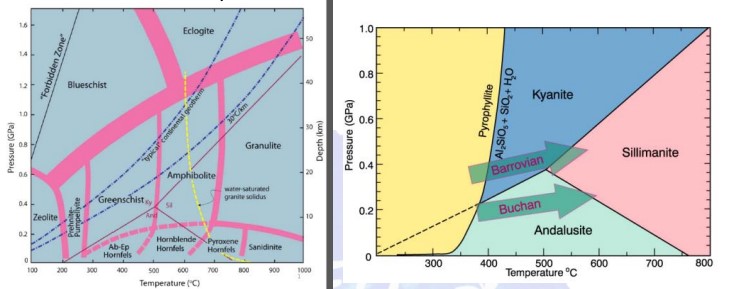
Economic Importance of Dharwarian Rocks
- The Archean Group of rocks, including the Dharwar Supergroup, is regarded as India’s most important economic mineral-bearing group. Most economic minerals, such as iron, copper, manganese, lead, zinc, and gold, come from Archean rocks.
- Mineralization:
- Western Block: Characterized by copper, iron, and manganese mineralization.
- Eastern Block: Known for gold, iron, and manganese mineralization.
- Magnesite: Occurs in veins in the serpentinized dunite belonging to the Sargur Group.
- Chromite: Deposits occur in the lensoid bodies of serpentinite in the Nuggihalli belt of the Sargur Group.
- Gold: Strong structural control on the gold mineralization in the Kolar Schist Belt.
- Copper Sulphide: Occurs together with the sulfides of lead and zinc forming stratiform deposits (Chitradurga Group).
- Manganese Minerals: Pyrolusite and psilomelane occur in the schist belts, in association with limestones and banded ferruginous cherts of the Dharwar Supergroup in the Shimoga, Chitradurga, Sandur, and Uttara Kannada belts.
Life in the Dharwar Craton
In the Indian Shield, life appeared about 3.8 billion years ago. In the Dharwar Craton, stromatolites in the carbonate rocks of the Chitradurga Group reveal the existence and development of cyanobacterial life. Phormidella (cyanobacteria) preserved in black chert from the Donimalai sequence in the Sandur Schist Belt, coeval with the Dharwar Supergroup, further highlights the early presence of life in this region.